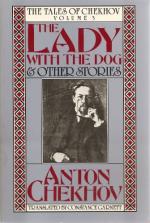|
This section contains 9,395 words (approx. 32 pages at 300 words per page) |

|
SOURCE: Kramer, Karl D. “Stories of Ambiguity.” In The Chameleon and the Dream, pp. 153–73. The Hague, the Netherlands: Mouton & Co. B. V., 1970.
In the following essay, Kramer discusses ambiguities in meaning as seen in Chekhov's stories.
One could, with respect to terminology, talk about either ambiguity or paradox in describing that particular aspect of Čexov's work which in volves the concept of meaning in the later stories. If the term ‘ambiguity’ ordinarily denotes situations in which two or more interpretations can coexist, then it refers to a “both-and” type of relationship. The term ‘paradox’ normally indicates contradictory meanings, and thus refers to an “either-or” situation. The difficulty in regard to Čexov is that the two or more meanings of a given story are ordinarily opposed to each other. However, there is some precedent for calling this relationship ambiguous: William Empson's last two categories of ambiguity involve contradictory meanings...
|
This section contains 9,395 words (approx. 32 pages at 300 words per page) |

|


